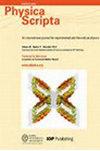The mechanism of adjusting the low-frequency ultra-wide band gap within lightweight spherical superstructue
IF 2.6
3区 物理与天体物理
Q2 PHYSICS, MULTIDISCIPLINARY
引用次数: 0
Abstract
Conventional resonant structures can be effective in obtaining broadband, but it is still a challenge to design small-sized and lightweight acoustic metamaterials with a low-frequency ultra-wideband. This paper proposes a new approach of designing a lightweight spherical localized resonance superstructure with adjustable stiffness ratio, and the mechanism of adjusting the low-frequency ultra-wide forbidden band is revealed. Then, the correlation between the zero value of its dynamic equivalent mass and the stiffness ratio of the system is studied. It is found that not only is the upper bound of the negative mass effectively broadened, but also the lower bound is successfully lowered only by adjusting the stiffness ratio of the sphere. Most importantly, based on the regulation mechanism with adjustable stiffness ratio, the lower boundary of the band gap is lowered from 171 Hz to 141 Hz, and the upper boundary is increased from 445 Hz to 710 Hz. Therefore, the low-frequency ultra-wideband of 141–710 Hz is obtained only by adjusting the stiffness ratio of the system and the Finite Element Method, which is highly consistent with theoretical analyses. Obviously, the mechanism of obtaining the low-frequency wideband through adjusting the stiffness ratio not only provides a novel idea for adjusting the low-frequency ultra-wideband, but also provides theoretical guidance for the developing the small-size and lightweight acoustic devices, so it would have potential application in the field of vibration and noise reduction.轻质球形上层结构内部低频超宽带隙的调节机制
传统的谐振结构可以有效地获得宽带,但要设计出具有低频超宽禁带的小型轻质声学超材料仍是一项挑战。本文提出了一种设计刚度比可调的轻质球形局部共振超结构的新方法,并揭示了低频超宽禁带的调节机理。然后,研究了其动态等效质量零值与系统刚度比之间的相关性。研究发现,仅通过调节球体的刚度比,不仅能有效拓宽负质量的上限,还能成功降低其下限。最重要的是,基于可调刚度比的调节机制,带隙的下限从 171 Hz 降至 141 Hz,上限从 445 Hz 升至 710 Hz。因此,仅通过调整系统的刚度比和有限元法就能获得 141-710 Hz 的低频超宽带,这与理论分析高度一致。显然,通过调整刚度比获得低频宽带的机理不仅为调整低频超宽带提供了新思路,而且为开发小型轻量化声学器件提供了理论指导,因此在减振降噪领域具有潜在的应用前景。
本文章由计算机程序翻译,如有差异,请以英文原文为准。
求助全文
约1分钟内获得全文
求助全文
来源期刊

Physica Scripta
物理-物理:综合
CiteScore
3.70
自引率
3.40%
发文量
782
审稿时长
4.5 months
期刊介绍:
Physica Scripta is an international journal for original research in any branch of experimental and theoretical physics. Articles will be considered in any of the following topics, and interdisciplinary topics involving physics are also welcomed:
-Atomic, molecular and optical physics-
Plasma physics-
Condensed matter physics-
Mathematical physics-
Astrophysics-
High energy physics-
Nuclear physics-
Nonlinear physics.
The journal aims to increase the visibility and accessibility of research to the wider physical sciences community. Articles on topics of broad interest are encouraged and submissions in more specialist fields should endeavour to include reference to the wider context of their research in the introduction.
 求助内容:
求助内容: 应助结果提醒方式:
应助结果提醒方式:


